#asia research news
Explore tagged Tumblr posts
Text
"A 25-year-old woman in China is the first person worldwide to have type 1 diabetes reversed through stem cell therapy.
The therapy used the patient’s own cells to create personalized stem cells, which were then used to grow fresh insulin-producing islets.
This breakthrough offers hope for millions with diabetes, potentially eliminating the need for daily insulin injections and reducing complications.
In a groundbreaking medical achievement, a 25-year-old woman in Tianjin, China, has had her type 1 diabetes reversed through a novel stem cell therapy. This marks the first time such a feat has been accomplished globally, offering new hope for millions living with the chronic condition.
The patient, who had been struggling with type 1 diabetes, underwent a pioneering treatment that involved converting her own cells into personalized stem cells. These stem cells were then used to grow fresh clusters of ‘islets,’ the hormone-producing cells in the pancreas responsible for regulating blood sugar levels.
As Nature reports, this therapy’s unique approach of transplanting the newly created islets into the patient’s upper abdomen near her pancreas sets it apart from previous islet transplant methods. This strategic placement allows for easier monitoring via MRI, a significant advantage over traditional liver transplants.
“I can eat sugar now,” the woman said on a call with Nature. After over a year since the transplant, she says, “I enjoy eating everything — especially hotpot.” The woman asked to remain anonymous for privacy reasons.
Experts are astonished at the results, according to Timesnownews. “They’ve completely reversed diabetes in the patient, who was requiring substantial amounts of insulin beforehand,” said Dr. James Shapiro, a transplant surgeon and researcher at the University of Alberta in Edmonton, Canada.
The implications of this breakthrough are far-reaching, as it could potentially revolutionize the way we treat diabetes. By using a patient’s own cells to create personalized stem cells, this therapy bypasses the limitations of donor islet shortages and the need for immunosuppressive drugs, which have hindered the success of conventional transplant methods.
‘If this is applicable to other patients, it’s going to be wonderful,’ diabetes researcher Daisuke Yabe of Japan’s Kyoto University told reporters via Daily Mail.
As the world watches closely, the success of this case sparks hope for the millions of individuals living with type 1 diabetes. It represents a significant step forward in regenerative medicine and paves the way for further research and development in the field."
-via Gadget Review, September 30, 2024
#diabetes#type 1 diabetes#stem cell therapy#stem cell treatment#stem cell research#china#asia#medical news#public health#good news#hope
2K notes
·
View notes
Text
i just learnt that the continents that you learn in school depend on the country, and that some countries teach in schools that there are 7 continents and other teach that there are 6, but there are also models that only count 5 or even 4 continents
#i just thought i wasn't up to date with our geological research#cause i was taught that america is just one big continent#(and then there's europe asia africa australia and antarctica)#and i when i saw people saying that north america and south america are two different continents i was confused#turns out that's the model used in english-speaking countries#and that romance-speaking countries usually consider america one big continent#so that's interesting#one new thing i've learnt i guess!!
4 notes
·
View notes
Text
*
#the last two weeks have been mental#I passed in my last paper for this term on the 24th#which means I’m officially done with the first year of my PhD#and I got news yesterday that I got a high pass on my French translation exam#so I only have to take one more test (could be in Russian or Portuguese or Hebrew or Arabic. my choice based on what I already have) to#finish my language requirements#[which is one of those things that doesn’t seem like a big deal but you can’t go to prospectus defense without it done]#and to multiply the crazy#the Friday before last#I got news that a proposal is submitted to a call for chapters (which I 100% thought I would be turned down on) was accepted#so I’m going to have a whole 40-50 page research project brought out as a chapter in a book by a major U.S. university press#never mind that I’m leaving in 2 weeks#to travel around Europe and Asia for the next 3 months doing research work and visiting friends#I was at such a low point at the start of this term 2 or 3 months ago#burned out and not feeling good about my work and just generally having a time of it with everything#but it feels like everything has turned around so drastically in such a short amount of time#and pushing myself through the bad/hard parts was worth it to come out the other end#anyway I’m rambling#but it’s been amazing to get things to look forward to and move towards making real accomplishments#especially after not sleeping more than 5 hours a night for like 9 months#not the stones#me stuff
3 notes
·
View notes
Text

0 notes
Text
AMRO sees Philippine economy growing 6.1% to 6.3% in 2025
In its recent update, the ASEAN+3 Macroeconomic Research Office (AMRO) sees the economy of the Philippines achieving growth of 6.1% to 6.3% in 2025, according to a BusinessWorld news report. To put things in perspective, posted below is an excerpt from the BusinessWorld report. Some parts in boldface… THE PHILIPPINES will likely post the second-fastest growth in the Association of Southeast…
#ASEAN#ASEAN+3 Macroeconomic Research Office (AMRO)#Asia#Blog#blogger#blogging#business#business confidence#business news#BusinessWorld#Carlo Carrasco#China#economic dynamism#economic growth#economics#economy#Economy of the Philippines#finance#geek#gross domestic product (GDP)#growth#Hong Kong#Japan#journalism#money#news#Philippines#Philippines blog#Pinoy#Southeast Asia
0 notes
Text
The market size of the Southeast Asia Ceramic Tiles industry is estimated to grow at a CAGR of around 7.58% during the forecast period, i.e., 2023-28. The rapid growth of the travel and tourism industry and rising infrastructure developments across the region contributed to this growth.
#Southeast Asia Ceramic Tiles industry#Southeast Asia Ceramic Tiles industry Report#Southeast Asia Ceramic Tiles industry Growth#Southeast Asia Ceramic Tiles industry Size#Southeast Asia Ceramic Tiles industry Share#Southeast Asia Ceramic Tiles industry Price#Southeast Asia Ceramic Tiles Market#Southeast Asia Ceramic Tiles Market News#Southeast Asia Ceramic Tiles Market report#Southeast Asia Ceramic Tiles Market Share#Southeast Asia Ceramic Tiles Market Forecast#Market Research Report
0 notes
Text
Kim Jong Un talks up North Korea's nuclear capability as daughter watches latest missile test | CNN
CNN — North Korea must be ready to launch nuclear counter strikes at any time to deter war, state media quoted leader Kim Jong Un as saying on Monday, as he accused the United States and South Korea of expanding joint military drills near the country’s doorstep. Kim’s remarks came after “guiding” combined tactical drills of operational units simulating a nuclear counterattack against North…

View On WordPress
#aircraft#asia#aviation and aerospace industry#brand safety-nsf sensitive#brand safety-nsf war and military#brand safety-nsf weapons#Business#business and industry sectors#conflicts and war#continents and regions#defense industry#defense research#domestic alerts#domestic-international news#domestic-us politics#east asia#economy and trade#iab-aviation industry#iab-business and finance#iab-defense industry#iab-industries#international alerts#international-us politics#kim il sung#kim jong il#kim jong un#kim ju-ae#military#military aircraft#military operations
0 notes
Text
Good News - June 15-21
Like these weekly compilations? Tip me at $Kaybarr1735! And if you tip me and give me a way to contact you, at the end of the month I'll send you a link to all of the articles I found but didn't use each week!
1. Victory for Same-Sex Marriage in Thailand
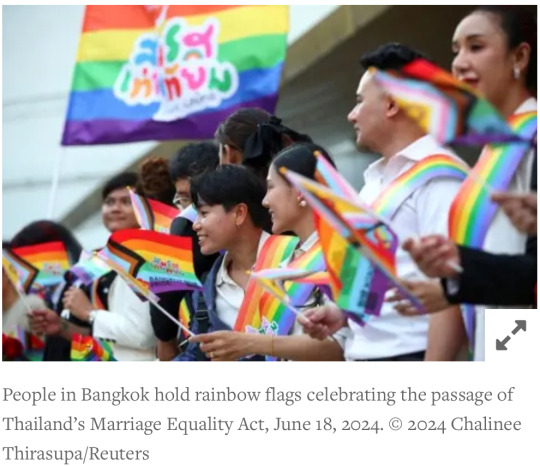
“Thailand’s Senate voted 130-4 today to pass a same-sex marriage bill that the lower house had approved by an overwhelming majority in March. This makes Thailand the first country in Southeast Asia, and the second in Asia, to recognize same-sex relationships. […] The Thai Marriage Equality Act […] will come into force 120 days after publication in the Royal Gazette. It will stand as an example of LGBT rights progress across the Asia-Pacific region and the world.”
2. One of world’s rarest cats no longer endangered
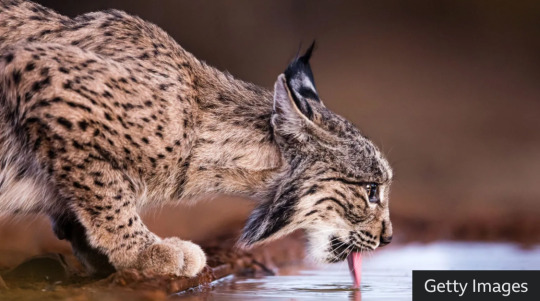
“[The Iberian lynx’s] population grew from 62 mature individuals in 2001 to 648 in 2022. While young and mature lynx combined now have an estimated population of more than 2,000, the IUCN reports. The increase is largely thanks to conservation efforts that have focused on increasing the abundance of its main food source - the also endangered wild rabbit, known as European rabbit. Programmes to free hundreds of captive lynxes and restoring scrublands and forests have also played an important role in ensuring the lynx is no longer endangered.”
3. Planning parenthood for incarcerated men
“[M]any incarcerated young men missed [sex-ed] classroom lessons due to truancy or incarceration. Their lack of knowledge about sexual health puts them at a lifelong disadvantage. De La Cruz [a health educator] will guide [incarcerated youths] in lessons about anatomy and pregnancy, birth control and sexually transmitted infections. He also explores healthy relationships and the pitfalls of toxic masculinity. […] Workshops cover healthy relationships, gender and sexuality, and sex trafficking.”
4. Peru puts endemic fog oasis under protection

“Lomas are unique ecosystems relying on marine fog that host rare and endemic plants and animal species. […] The Peruvian government has formally granted conservation status to the 6,449-hectare (16,000-acre) desert oasis site[….] The site, the first of its kind to become protected after more than 15 years of scientific and advocacy efforts, will help scientists understand climatic and marine cycles in the area[, … and] will be protected for future research and exploration for at least three decades.”
5. Religious groups are protecting Pride events — upending the LGBTQ+ vs. faith narrative

“In some cases, de-escalation teams stand as a physical barrier between protesters and event attendees. In other instances, they try to talk with protesters. The goal is generally to keep everyone safe. Leigh was learning that sometimes this didn’t mean acting as security, but doing actual outreach. That might mean making time and space to listen to hate speech. It might mean offering food or water. […] After undergoing Zoom trainings this spring, the members of some 120 faith organizations will fan out across more than 50 Pride events in 16 states to de-escalate the actions of extremist anti-LGBTQ+ hate groups.”
6. 25 years of research shows how to restore damaged rainforest
“For the first time, results from 25 years of work to rehabilitate fire-damaged and heavily logged rainforest are now being presented. The study fills a knowledge gap about the long-term effects of restoration and may become an important guide for future efforts to restore damaged ecosystems.”
7. Audubon and Grassroots Carbon Announce First-of-its-Kind Partnership to Reward Landowners for Improving Habitats for Birds while Building Healthy Soils

“Participating landowners can profit from additional soil carbon storage created through their regenerative land management practices. These practices restore grasslands, improve bird habits, build soil health and drive nature-based soil organic carbon drawdown through the healthy soils of farms and ranches. […] Additionally, regenerative land management practices improve habitats for birds. […] This partnership exemplifies how sustainable practices can drive positive environmental change while providing tangible economic benefits for landowners.”
8. Circular food systems found to dramatically reduce greenhouse gas emissions, require much less agricultural land
“Redesigning the European food system will reduce agricultural land by 44% while dramatically reducing greenhouse gas emissions from agriculture by 70%. This reduction is possible with the current consumption of animal protein. “Moreover, animals are recyclers in the system. They can recycle nutrients from human-inedible parts of the organic waste and by-products in the food system and convert them to valuable animal products," Simon says.”
9. Could Treating Injured Raptors Help Lift a Population? Researchers found the work of rehabbers can have long-lasting benefits
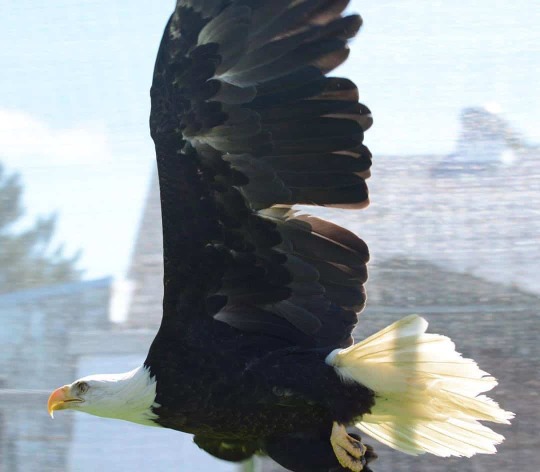
“[“Wildlife professionals”] tend to have a dismissive attitude toward addressing individual animal welfare,” [… but f]or most raptor species, they found, birds released after rehabilitation were about as likely to survive as wild birds. Those released birds can have even broader impacts on the population. Back in the wild, the birds mate and breed, raising hatchlings that grow up to mate and breed, too. When the researchers modeled the effects, they found most species would see at least some population-level benefits from returning raptors to the wild.”
10. Indigenous people in the Amazon are helping to build bridges & save primates
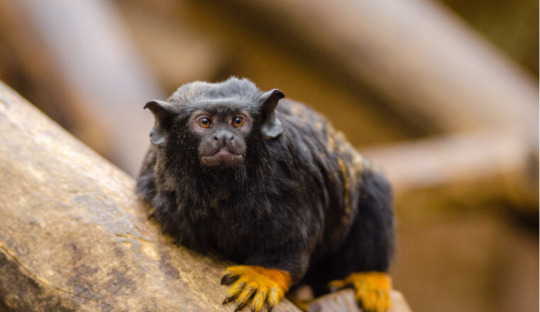
“Working together, the Reconecta Project and the Waimiri-Atroari Indigenous people build bridges that connect the forest canopy over the BR-174 road[….] In the first 10 months of monitoring, eight different species were documented — not only monkeys such as the golden-handed tamarin and the common squirrel monkey (Saimiri sciureus), but also kinkajous (Potos flavus), mouse opossums (Marmosops sp.), and opossums (Didelphis sp.).”
Bonus: A rare maneless zebra was born in the UK
June 8-14 news here | (all credit for images and written material can be found at the source linked; I don’t claim credit for anything but curating.)
#hopepunk#good news#lgbtq#gay rights#gay marriage#same sex marriage#thailand#lynx#big cats#cats#endangered species#endangered#sex education#prison#peru#conservation#habitat#religion#pride#faith#pride month#lgbt pride#compassion#rainforest#birds#nature#climate change#wildlife rehab#wildlife#indigenous
1K notes
·
View notes
Text
The Oriental Blue Clearwing Moth: these moths were regarded as a "lost species" for more than 130 years, until they were finally sighted again in 2013
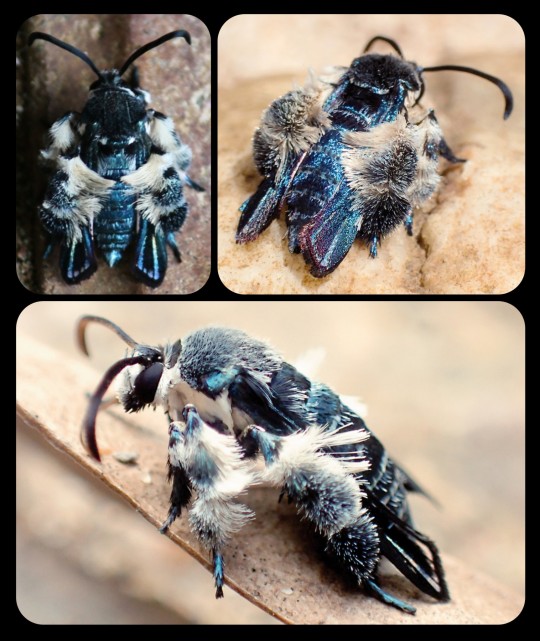
For more than 130 years, the Oriental blue clearwing moth (Heterosphecia tawonoides) was known only from a single, badly damaged specimen that was collected in Sumatra in 1887. There were no recorded sightings of this species again until 2013, when entomologist Dr. Marta Skowron Volponi unexpectedly found the moths feeding on salt deposits that had accumulated along the riverbanks in Malaysia's lowland rainforest.
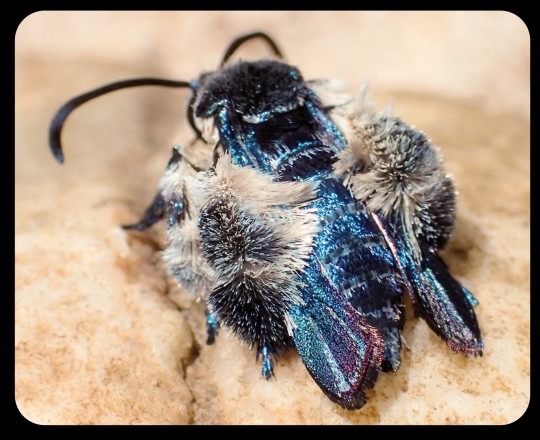
These moths were observed by researchers again in 2016 and 2017, and research indicates that the moths are actually bee-mimics, as they mimic the appearance, sound, behavior, and flight patterns of local bees. Their fuzzy, bright blue appearance might seem a little out of place for a bee-mimic, but those features do appear in several different bee species throughout Southeast Asia.
When the moths are in flight, they bear a particularly strong resemblance to the bees of the genus Thyreus (i.e. cuckoo bees, otherwise known as cloak-and-dagger bees), several of which are also bright blue, with banded markings, dark blue wings, fuzzy legs, and smooth, rounded antennae. The physical resemblance is compounded by the acoustic and behavioral mimicry that occurs when the moths are in flight.
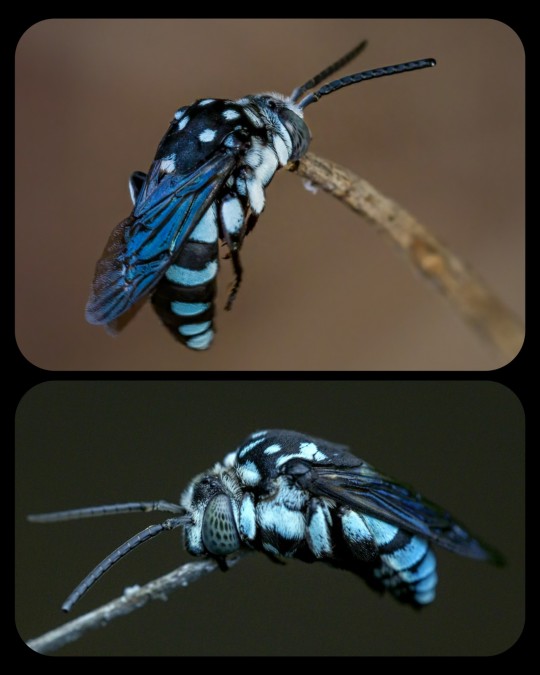
Cloak-and-Dagger Bees: the image at the top shows an Indo-Malayan cloak-and-dagger bee (Thyreus novaehollandiae) in a sleeping position, holding itself upright with its mandibles clamped onto a twig, while the image at the bottom shows a Himalayan cloak-and-dagger bee (T. himalayensis) resting in the same position
The moths also engage in "mud-puddling" among the various bees that congregate along the riverbanks; mud-puddling is the process whereby an insect (usually a bee or a butterfly) draws nutrients from the fluids found in puddles, wet sand, decaying plant matter, carrion, animal waste, sweat, tears, and/or blood. According to researchers, the Oriental blue clearwing moth was the only lepidopteran that was seen mud-puddling among the local bees.
Dr. Skowron Volponi commented on the unusual appearance and behavior of these moths:
You think about moths and you envision a grey, hairy insect that is attracted to light. But this species is dramatically different—it is beautiful, shiny blue in sunlight and it comes out during the day; and it is a master of disguise, mimicking bees on multiple levels and even hanging out with them. The Oriental blue clearwing is just two centimeters in size, but there are so many fascinating things about them and so much more we hope to learn.
This species is still incredibly vulnerable, as it faces threats like deforestation, pollution, and climate change. The president of Global Wildlife Conservation, which is an organization that seeks to rediscover "lost species," added:
After learning about this incredible rediscovery, we hope that tourists visiting Taman Negara National Park and picnicking on the riverbanks—the home of these beautiful clearwing moths—will remember to tread lightly and to take their trash out of the park with them. We also recommend that Americans learn about palm oil production, which is one of the primary causes of deforestation in Malaysia.
Sources & More Info:
Phys.org: Bee-Mimicking Clearwing Moth Buzzes Back to Life After 130 Years
Mongabay News: Moth Rediscovered in Malaysia Mimics Appearance and Behavior of Bees to Escape Predators
Journal of Tropical Conservation Science: Lost Species of Bee-Mimicking Clearwing Moth, H. tawonoides, Rediscovered in Peninsular Malaysia's Primary Rainforest
Frontiers in Zoology: Southeast Asian Clearwing Moths Buzz like their Model Bees
Royal Society Publishing: Moving like a Model - mimicry of hymenopteran flight trajectories by clearwing moths of Southeast Asian rainforests
Medium: Rediscovery in a Glint of Blue
re:wild.org: The "Search for Lost Species" Project
#lepidoptera#moths#heterosphecia tawonoides#oriental blue clearwing moth#entomology#insects#cute bugs#nature#animals#lost species#mimicry#evolution#bees#southeast asia#Malaysia#colorful moths#bee mimic#science
1K notes
·
View notes
Text

Neo-Nazis and white supremacists are sharing Hitler-related propaganda and trying to recruit new members on TikTok, according to a new report from the Institute for Strategic Dialogue (ISD) shared exclusively with WIRED. The TikTok algorithm is also promoting this content to new users, researchers found, as extremist communities are leveraging the huge popularity of TikTok among younger audiences to spread their message.
The report from ISD details how hundreds of extremist TikTok accounts are openly posting videos promoting Holocaust denial and the glorification of Hitler and Nazi-era Germany, and suggesting that Nazi ideology is a solution to modern-day issues such as the alleged migrant invasion of Western countries. The accounts also show support for white supremacist mass shooters and livestream-related footage or recreations of these massacres. Many of the accounts use Nazi symbols in their profile pictures or include white supremacist codes in their usernames.
Nathan Doctor, an ISD researcher who authored the report, says he began his investigation earlier this year when he came across one neo-Nazi account on TikTok while conducting research for another project.
He was quickly able to unmask a much broader network of accounts that appeared to be actively helping each other through liking, sharing, and commenting on each other’s accounts in order to increase their viewership and reach.
The groups promoting neo-Nazi narratives are typically siloed in more fringe platforms, like Telegram, the encrypted messaging app. But Telegram has become a place to discuss recruitment techniques for TikTok specifically: White supremacist groups there share videos, images, and audio tracks that members can use, explicitly telling other members to cross-post the content on TikTok.
“We posted stuff on our brand new tiktok account with 0 followers but had more views than you could ever have on bitchute or twitter,” one account in a Neo-Nazi group posted on Telegram about their outreach on TikTok. “It just reaches much more people.”
Others have followed suit. One prominent neo-Nazi has often asked his thousands of Telegram followers to “juice,” or algorithmically boost, his TikTok videos to increase their viral potential.
An extremist Telegram channel with 12,000 followers urged members to promote the neo-Nazi documentary Europa: The Last Battle by blanketing TikTok with reaction videos in an effort to make the film go viral. Researchers from ISD found dozens of videos on TikTok featuring clips from the film, some with over 100,000 views. “One account posting such snippets has received nearly 900k views on their videos, which include claims that the Rothschild family control the media and handpick presidents, as well as other false or antisemitic claims,” the researchers wrote.
This is far from the first time the role that TikTok’s algorithm plays in promoting extremist content has been exposed. Earlier this month, the Global Network on Extremism and Technology reported that TikTok’s algorithm was promoting the “adoration of minor fascist ideologues.” The same researchers found last year that it was boosting Eurocentric supremacist narratives in Southeast Asia. Earlier this month, WIRED reported how TikTok’s search suggestions were pushing young voters in Germany towards the far-right Alternative for Germany party ahead of last month’s EU elections.
“Hateful behavior, organizations and their ideologies have no place on TikTok, and we remove more than 98 percent of this content before it is reported to us,” Jamie Favazza, a TikTok spokesperson tells WIRED. “We work with experts to keep ahead of evolving trends and continually strengthen our safeguards against hateful ideologies and groups.”
Part of the reason platforms like TikTok have in the past been unable to effectively clamp down on extremist content is due to the use of code language, emojis, acronyms, and numbers by these groups. For example, many of the neo-Nazi accounts used a juice box emoji to refer to Jewish people.
“At present, self-identified Nazis are discussing TikTok as an amenable platform to spread their ideology, especially when employing a series of countermeasures to evade moderation and amplify content as a network,” the researchers write in the report.
But Doctor points out that even when viewing non-English-language content, spotting these patterns should be possible. “Despite seeing content in other languages, you can still pretty quickly recognize what it means,” says Doctor. “The coded nature of it isn't an excuse, because if it's pretty easily recognizable to someone in another language, it should be recognizable to TikTok as well.”
TikTok says it has more than “40,000 trust and safety professionals” working on moderation around the globe, and the company says its Trust and Safety Team has specialists in violent extremism who constantly monitor developments in these communities, including the use of new coded language.
While many of the identified accounts are based in the US, Doctor found that the network was also international.
“It's definitely global, it's not even just the English language,” Doctor tells WIRED. “We found stuff in French, Hungarian, German. Some of these are in countries where Naziism is illegal. Russian is a big one. But we even found things that were a bit surprising, like groups of Mexican Nazis, or across Latin America. So, yeah, definitely a global phenomenon.”
Doctor did not find any evidence that the international groups were actively coordinating with each other, but they were certainly aware of each others’ presence on TikTok: “These accounts are definitely engaging with each others' content. You can see, based on comment sections, European English-speaking pro-Nazi accounts reacting with praise toward Russian-language pro-Nazi content.”
The researchers also found that beyond individual accounts and groups promoting extremist content, some real-world fascist or far-right organizations were openly recruiting on the platform.
Accounts from these groups posted links in their TikTok videos to a website featuring antisemitic flyers and instructions on how to print and distribute them. They also boosted Telegram channels featuring more violent and explicitly extremist discourse.
In one example cited by ISD, an account whose username contains an antisemitic slur and whose bio calls for an armed revolution and the complete annihilation of Jewish people, has shared incomplete instructions to build improvised explosive devices, 3D-printed guns, and “napalm on a budget.”
To receive the complete instructions, the account holder urged followers to join a “secure groupchat” on encrypted messaging platforms Element and Tox. Doctor says that comments under the account holder’s videos indicate that a number of his followers had joined these chat groups.
ISD reported this account, along with 49 other accounts, in June for breaching TikTok’s policies on hate speech, encouragement of violence against protected groups, promoting hateful ideologies, celebrating violent extremists, and Holocaust denial. In all cases, TikTok found no violations, and all accounts were initially allowed to remain active.
A month later, 23 of the accounts had been banned by TikTok, indicating that the platform is at least removing some violative content and channels over time. Prior to being taken down, the 23 banned accounts had racked up at least 2 million views.
The researchers also created new TikTok accounts to understand how Nazi content is promoted to new users by TikTok’s powerful algorithm.
Using an account created at the end of May, researchers watched 10 videos from the network of pro-Nazi users, occasionally clicking on comment sections but stopping short of any form of real engagement such as liking, commenting, or bookmarking. The researchers also viewed 10 pro-Nazi accounts. When the researchers then flipped to the For You feed within the app, it took just three videos for the algorithm to suggest a video featuring a World War II-era Nazi soldier overlayed with a chart of US murder rates, with perpetrators broken down by race. Later, a video appeared of an AI-translated speech from Hitler overlaid with a recruitment poster for a white nationalist group.
Another account created by ISD researchers saw even more extremist content promoted in its main feed, with 70 percent of videos coming from self-identified Nazis or featuring Nazi propaganda. After the account followed a number of pro-Nazi accounts in order to access content on channels set to private, the TikTok algorithm also promoted other Nazi accounts to follow. All 10 of the first accounts recommended by TikTok to this account used Nazi symbology or keywords in their usernames or profile photos, or featured Nazi propaganda in their videos.
“In no way is this particularly surprising,” says Abbie Richards, a disinformation researcher specializing in TikTok. "These are things that we found time and time again. I have certainly found them in my research."
Richards wrote about white supremacist and militant accelerationist content on the platform in 2022, including the case of neo-Nazi Paul Miller, who, while serving a 41-month sentence for firearm charges, featured in a TikTok video that racked up more than 5 million views and 700,000 likes during the three months it was on the platform before being removed.
Marcus Bösch, a researcher based in Hamburg University who monitors TikTok, tells WIRED that the report’s findings “do not come as a big surprise,” and he’s not hopeful there is anything TikTok can do to fix the problem.
“I’m not sure exactly where the problem is,” Bösch says. “TikTok says it has around 40,000 content moderators, and it should be easy to understand such obvious policy violations. Yet due to the sheer volume [of content], and the ability by bad actors to quickly adapt, I am convinced that the entire disinformation problem cannot be finally solved, neither with AI nor with more moderators.”
TikTok says it has completed a mentorship program with Tech Against Terrorism, a group that seeks to disrupt terrorists’ online activity and helps TikTok identify online threats.
“Despite proactive steps taken, TikTok remains a target for exploitation by extremist groups as its popularity grows,” Adam Hadley, executive director of Tech Against Terrorism, tells WIRED. “The ISD study shows that a small number of violent extremists can wreak havoc on large platforms due to adversarial asymmetry. This report therefore underscores the need for cross-platform threat intelligence supported by improved AI-powered content moderation. The report also reminds us that Telegram should also be held accountable for its role in the online extremist ecosystem.”
As Hadley outlines, the report’s findings show that there are significant loopholes in the company’s current policies.
“I've always described TikTok, when it comes to far-right usage, as a messaging platform,” Richards said. “More than anything, it's just about repetition. It's about being exposed to the same hateful narrative over and over and over again, because at a certain point you start to believe things after you just see them enough, and they start to really influence your worldview.”
422 notes
·
View notes
Text
South Asian and Hindu Influences in ATLA (Part 1)
disclaimer: i was raised culturally and religiously hindu, and though i've tried to do my research for this post and pair it with my own cultural knowledge, i'm not an expert on hinduism by any means. should i mess up, please let me know.
please also be aware that many of the concepts discussed in this post overlap heavily with religions such as buddhism and jainism, which might have different interpretations and representations. as i'm not from those religions or cultures, i don't want to speak on them, but if anyone with that knowledge wishes to add on, please feel free.
it's well-known that atla draws from indigenous, east and southeast asian influences, but something i rarely see discussed in the fandom is the influences the show takes from hinduism and south asia, and there are actually far more than i think people are aware of.
so here's a (non-exhaustive list) of the main inspirations atla drew from south asian culture and hinduism, starting with...
The Avatar
the title of the show itself is taken from the ancient language of sanskrit, often considered the sacred tongue of the hindu religion. in sanskrit, the word "avatar" means to "descend" or "alight".
the concept of the avatar is a very old one, referring to the physical incarnation of a powerful deity or spirit. the idea of the avatar is most often linked to the god Vishnu, one of three supreme hindu gods collectively called the trimurti, or trinity. the avatar is said to manifest upon earth primarily in times of great need, when balance must be maintained between the forces of good and evil.
atla borrows heavily from this idea in having aang be the incarnation of a divine spirit who returns to the world during a time of immense strife, and is tasked with defeating a great evil to bring balance back to the world. and though i don't know if it was an intentional reference, it's interesting to note that Krishna, the most famous incarnation of Vishnu was also reborn amidst a fierce storm and carried through a raging sea to a new home where he would be protected from the king who sought to kill him. sounds a little familiar, doesn't it?
Agni Kai and the Philosophy of Firebending
the word "agni" derives from the sanskrit name Agni, the god of fire, though it can also generally mean "fire".
the concepts of lightning bending and the sun being the source of firebending are likely also taken from the idea of Agni, since he's said to exist simultaneously in three different forms on three different dimensions: as fire on earth, as lightning in the atmosphere, and as the sun in the sky.
Agni is a significant aspect of many rituals, including marriage rites, death rites, and the festivals of holi and diwali. the concept of Agni is one of duality: life and death, rebirth and destruction. hindu rituals accept and celebrate both aspects, revolving around the idea that destruction is not separate from creation, but rather necessary to facilitate it. the cremation of the dead, for instance, is seen as purification, not destruction: burning away the physical form so the soul is unencumbered, set free to continue the reincarnation cycle.
this influence can be seen in the firebending masters episode, which discusses the idea of fire being vital to life. the sun warriors safeguarding the original fire and demanding that zuko and aang bring fire to the dragons as a sacrifice could also reference the ritual of Agnihotra - the ritual of keeping a fire at the home hearth and making offerings to it. the purpose of this ritual differs depending on which text you refer to, but it is generally believed to purify the person and atmosphere in which it is performed, similar to how zuko and aang must make offerings to ran and shaw and survive their fire before being deemed worthy and pure.
Agnihotra is said to serve as a symbolic reminder of the vitality and importance of fire as the driving force of life, a lesson that zuko and aang also internalize from their encounter with the dragons.
Bumi
bumi's name is taken from the sanskrit word "bhumi", which means "earth". it's also the name of the hindu goddess of the earth, bumi or bhudevi.
one of the things the original animation didn't do and which i really enjoyed about the live action was that they made bumi indian and added desi inspiration to omashu. it makes perfect sense for a king whose name is as hindu-inspired as they come.
NWT Royal Palace
chief arnook's palace in the northern water tribe takes inspiration from the gopurams of hindu temples, massive pyramidal structures that served as entrance towers to the temple.


gopurams were built tall enough to be seen for miles around, beacons to signal tired or weary travellers who wished for a place to rest that a temple was nearby. it's a nice touch that the chief's palace is located in front of the spirit oasis, a similarly symbolic entryway to a sanctuary housing otherworldly deities.
Betrothal Necklaces
to preface: i doubt this was an intentional reference, and this great post talks about other cultures that could have inspired the water tribe betrothal necklaces. given the desi influence in the nwt architecture however, i figured it was worth mentioning.
the idea of betrothal necklaces being given to women by their male partners is similar to the thaali, a necklace given to hindu wives by their husbands. during hindu weddings, grooms tie the thaali around their brides' necks to symbolize their marriage. once given, wives are expected to wear their thaali till the day they die, as doing so is believed to bring good luck, health and prosperity to their husbands.
Chi-Blocking
though chi-blocking takes primary inspiration from the art of Dim Mak, it is also influenced by the south indian martial arts forms of adimurai and kalaripayattu, both of which include techniques of striking vital points in the body to disable or kill an opponent.
kalaripayattu also shares parallels with firebending, being a very physically demanding, aggressive martial art that emphasises the importance of discipline and mental fortitude. control of the mind is essential to control of the body, a philosophy similar to that espoused by iroh across the show.
Wan Shi Tong's Library


the library draws inspiration partly from the taj mahal, the famous mausoleum constructed by shah jahan during the mughal empire as a monument to his beloved wife, mumtaz mahal.
i'll end this post here since it's getting too long as it is, and the following section will be even longer. for while atla treated the concepts in this post with respect, the same unfortunately cannot be said for its depiction of guru pathik and combustion man - both of which we'll be discussing next.
841 notes
·
View notes
Text
Camera-trapping data revealed in a new study show a steady recovery of tigers in Thailand’s Western Forest Complex over the past two decades.
The tiger recovery has been mirrored by a simultaneous increase in the numbers of the tigers’ prey animals, such as sambar deer and types of wild cattle.
The authors attribute the recovery of the tigers and their prey to long-term efforts to strengthen systematic ranger patrols to control poaching as well as efforts to restore key habitats and water sources.
Experts say the lessons learnt can be applied to support tiger recovery in other parts of Thailand and underscore the importance of the core WEFCOM population as a vital source of tigers repopulating adjacent landscapes.
The tiger population density in a series of protected areas in western Thailand has more than doubled over the past two decades, according to new survey data.
Thailand is the final stronghold of the Indochinese tiger (Panthera tigris corbetti), the subspecies having been extirpated from neighboring Cambodia, Laos and Vietnam over the past decade due to poaching, habitat loss and indiscriminate snaring...
Fewer than 200 tigers are thought to remain in Thailand’s national parks and wildlife sanctuaries, only a handful of which are sufficiently undisturbed and well-protected to preserve breeding tigers.
The most important of these protected areas for tigers is the Huai Kha Khaeng Thung Yai (HKK-TY) UNESCO World Heritage Site, which comprises three distinct reserves out of the 17 that make up Thailand’s Western Forest Complex (WEFCOM). Together, these three reserves — Huai Kha Khaeng Wildlife Sanctuary, Thungyai Naresuan West and Thungyai Naresuan East — account for more than a third of the entire WEFCOM landscape.
Now, a new study published in Global Ecology and Conservation documents a steady recovery of tigers within the HKK-TY reserves since camera trap surveys began in 2007. The most recent year of surveys, which concluded in November 2023, photographed 94 individual tigers, up from 75 individuals in the previous year, and from fewer than 40 in 2007.
Healthy tiger families
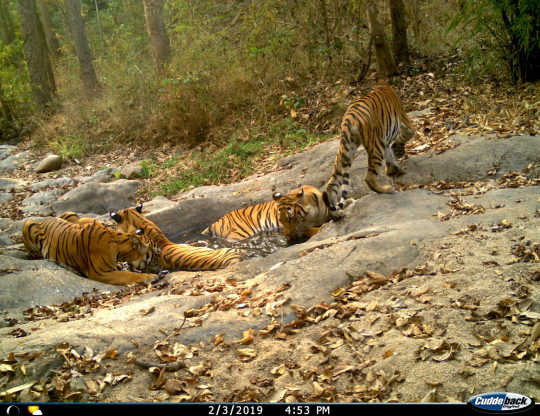
The study findings reveal that the tiger population grew on average 4% per year in Hua Kha Khaeng Wildlife Sanctuary, the largest and longest-protected of the reserves, corresponding to an increase in tiger density from 1.3 tigers per 100 square kilometers, to 2.9 tigers/100 km2.
“Tiger recoveries in Southeast Asia are few, and examples such as these highlight that recoveries can be supported outside of South Asia, where most of the good news [about tigers] appears to come from,” said Abishek Harihar, tiger program director for Panthera, the global wildcat conservation organization, who was not involved in the study.
Among the camera trap footage gathered in HKK-TY over the years were encouraging scenes of healthy tiger families, including one instance of a mother tiger and her three grownup cubs lapping water and lounging in a jacuzzi-sized watering hole. The tiger family stayed by the water source for five days during the height of the dry season.
The team of researchers from Thailand’s Department of National Parks, Wildlife and Plant Conservation, the Wildlife Conservation Society, Kasetsart University, and India’s Center for Wildlife Studies deployed camera traps at more than 270 separate locations throughout the HKK-TY reserves, amassing 98,305 days’ worth of camera-trap data over the 19-year study period.
Using software that identifies individual tigers by their unique stripe patterns, they built a reference database of all known tigers frequenting the three reserves. A total of 291 individual tigers older than 1 year were recorded, as well as 67 cubs younger than 1 year [over the course of the study].
Ten of the tigers were photographed in more than one of the reserves, indicating their territories straddled the reserve boundaries. The authors conclude that each of the three reserves has a solid breeding tiger population and that, taken together, the HKK-TY landscape is a vital source of tigers that could potentially repopulate surrounding areas where they’ve been lost. This is supported by cases of known HKK-TY tigers dispersing into neighboring parts of WEFCOM and even across the border into Myanmar.
Conservation efforts pay off
Anak Pattanavibool, study co-author and Thailand country director at the Wildlife Conservation Society, told Mongabay that population models that take into account the full extent of suitable habitat available to tigers within the reserves and the likelihood that some tigers inevitably go undetected by camera surveys indicate there could be up to 140 tigers within the HKK-YT landscape.
Anak told Mongabay the tiger recovery is a clear indication that conservation efforts are starting to pay off. In particular, long-term action to strengthen systematic ranger patrols to control poaching as well as efforts to boost the tigers’ prey populations seem to be working, he said.
“Conservation success takes time. At the beginning we didn’t have much confidence that it would be possible [to recover tiger numbers], but we��ve been patient,” Anak said. For him, the turning point came in 2012, when authorities arrested and — with the aid of tiger stripe recognition software — prosecuted several tiger-poaching gangs operating in Huai Kha Khaeng. “These cases sent a strong message to poaching gangs and they stopped coming to these forests,” he said."
...ranger teams have detected no tiger poaching in the HKK-TY part of WEFCOM since 2013.
-via Mongabay News, July 17, 2024
#tigers#thailand#thai#endangered species#big cats#conservation#wildlife#wildlife conservation#wildlife photography#poaching#good news#hope
2K notes
·
View notes
Text

Portraying Sophie Baek:
A guide to cultural sensitivity and respect
Things to keep in mind
———
Yay! Sophie Baek is finally here and with all of excitement of this casting, I think it’s also important to bring attention to the new intersectionality that comes with the character of Sophie (specifically show Sophie).
Why should you take my words into account? Well, as an Asian woman in society today, I feel that I am qualified to speak on this topic since I’ve experienced all of this.
All of my words come from kind intentions, and I purely just want to communicate to the fandom how to approach Sophie being Asian in a respectful way.
Asia is a gigantic continent filled with various countries that have a multitude of cultures and ethnicities. While on the surface they all seem similar, they each have their own customs and traditions that have meaning within our culture. Do not combine them.
It’s important to remember that not every Asian person is Chinese, Japanese or Korean (East asian).
With Sophie being Korean, please do not generalize when writing about what you think you know about Korean culture.
You like Kpop and Kdrama? Great! BUT that does not define what Korean culture is and you shouldn't use that content as a reference.
When writing, be aware of explicit and unconscious biases you have about Asian people.
Asian stereotypes (Model Minority, Dragon Lady, Lotus blossom, etc) are very harmful and spread false narratives about us. Stereotypes eliminate the dimensions of who we are as Asians (South, South East, East, North, West).
Please, please, please do not fetishize. Especially since Bridgerton is a romance series it's extremely important to be mindful of the scenarios you put in your fics.
This also includes the White Savior Complex we see a lot in media!
If you’re writing about something specific, research it and fully understand the content you are putting into your work. Feel a little iffy about if you should put it in your fic? Probably don’t then. It’s that easy!
It's always great to ask someone who is a part of the community as well to see if what you're writing about is appropriate or potentially offensive in any way.
Describing Sophie is something new as well. Be mindful on how you describe her and other Asian characters.
Let me be clear: descriptions like 'slanted eyes' or 'yellow skin' are harmful
Here are some great resources that go into further detail about specific things! Rather than me paraphrasing their words it's best to link the direct source. Even as a part of this community, these articles were a reminder of how I must keep myself in check as well!
Describing Asian Eyes
Some important tips on making/writing Asian OCs
writing east asian characters
The Depiction of Asian Characters - Book Edition
The Dragon Lady, the Lotus Blossom, and the Robot: Archetypes of Asian Women in Western Media
To wrap this up, I want to be clear that I’m not a professional on this topic, but as someone who has been affected by harmful portrayals in media, I feel compelled to share my perspective. My hope is to spread awareness and encourage others to be mindful of how they approach these subjects, especially if they may not be fully informed. It’s about showing respect, doing the necessary research, and recognizing the impact our words and content can have on real people and cultures. By staying educated and considerate, we can be more aware and thoughtful in our actions.
#researching before writing about Sophie? very mindful very considerate#pls pls don’t write anything offensive 😘#shout out to the group chat for proofing!!#my protectiveness and connection to Sophie has multiple so much now that she’s Asian#u know who u r 🫶🏼#bridgerton#benedict bridgerton#sophie beckett#benophie#sophie baek#asian sophie#bridgerton writing#bridgerton fic
312 notes
·
View notes
Text



so this is a trashfire for many reasons.
lack of historical knowledge and complete lack of perspective
israel was not created by britain. israel declared independence from britain. israel was not "designed to funnel jewish people out of all other countries." israel is not "puppeted by america for the purposes of colonizing southwest asia" and the insinuation that israel's goal is to colonize the entirety of southwest asia is actually a documented antisemitic conspiracy theory.
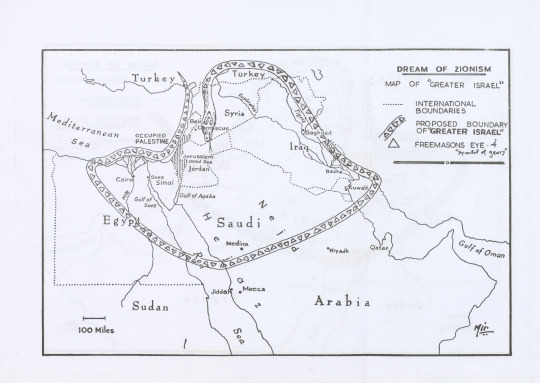
"Even before the State of Israel came into existence, Arab leaders accused Zionists of seeking to rule most of the Middle East," a secret Jewish plot to establish a "Greater Israel" extending from the Nile to the Eurphrates and the Persian Gulf, and south deep into Saudi Arabia. Albeit "farfetched" and a "calumny," this notion has "become so routinized and accepted" that it "now serves as the conventional wisdom in all the Arabic-speaking countries and Iran." Pipes 1998, 49, 69. This is one of two maps in the collection alleged to provide evidence of the "Greater Israel" conspiracy. (The other is ID #2411, "Jewish Imperial Ambitions In Palestine and Neighbouring Countries," 1967.) This map, "Dream of Zionism," shows Zionism as a giant serpent, its back decorated with a pattern of triangles described as "Freemasons Eye, 'Symbol of Jewry.'" The snake's circular outline marks the "Proposed Boundary of 'Greater Israel,'" an area including all of Jordan, Lebanon, Syria, and the Sinai Peninsula; the Nile delta region of Egypt along the Suez Canal and northwest of Cairo; and virtually all of Iraq, including access to the Persian Gulf. It also includes a large portion of northwestern Saudi Arabia, a corridor well over 100 miles wide along the Red Sea, stretching south more than 450 miles from the Gulf of Aqaba to the Holy City of Medina. "Curiously," the conspiracy theorists "see Greater Israel including Medina but not Mecca; the oil fields of Kuwait but not those of Saudi Arabia; and more of Turkey than Iran." The State of Israel is identified as "Occupied Palestine." Pipes 62. This map first appeared in an English-language edition of the fraudulent "Protocols of the Elders of Zion" - the infamous blood libel against the Jewish people - published in Iran in 1985. Ibid. This version appears in a new edition, "Protocols of the Learned Elders of Zion," attributed to "The Representatives of Zion, of the 33rd Degree" and published in Kuwait by the "Scientific Research House." The estimated publication date is 2018. The current version of the map varies only slightly from that of 1985 illustrated in Pipes: the words "Symbol of Jewry" have been added in script beneath the legend "Freemasons Eye," and a partially legible signature ("Mir"?) appears at the lower right.
also i'm not sure what the intention was with bringing up the rwandan genocide because rwanda was colonized by germany and belgium, not the british. unless you think literally everything bad that happens in the world is tied to britain... which just so happens to be another antisemitic conspiracy theory that originated in the ussr. all the while jews were being demonized in the uk for being "communist sympathizers." because jews are the symbol of everything you hate, all the problems in your life. that is how antisemitism functions.
2. tokenizing jews for your own benefit
"i had followed [jewish blogs] in an attempt to better understand jewish concerns ... and i've been unfollowing them one by one ... i was getting genuine perspectives on issues i knew very little about - and now, for those blogs in particular, it's impossible to separate what might be a genuine concern verses wht's being weaponised to justify a settler state"
this is an open admission that you are only able to take in jewish perspectives from jews you agree with. and considering the ignorance that's rampant in the rest of the post, my guess is that what you saw was jews who were scared and angry at the way people acted after october 7th and the way antisemitism is rising, but the non jews you follow were insistent that those sentiments could not coexist with palestinian liberation. additionally, the fact you are unable to separate genuine concern verses "what's being weaponised" is your own problem, not ours. the way jewish pain is being downplayed, mocked, ignored, and demonized, the way people have insisted that any mourning for the victims of october 7th or concern for the hostages must be propaganda is antisemitic. and you are actively contributing to that, particularly by saying that western powers arresting people during protests "has been a setup from the beginning" with the very clear insinuation that it is "zionists" who are to blame for the setup.
3. you are really fucking entitled
you are a british goy (not a "goyim" btw, goy is singular, goyim is plural). you literally admitted that you "don't know how to talk about this with the tat and care [you] should be as a [non jew]" and that "certainly there is a degree in arrogance for [you] to talk about judaism as an outsider." and yet you wrote this whole post full of antisemitic conspiracy theories and antisemitic biases while claiming you know how to protect jewish people and while claiming that zionism is "the biggest danger to jewish people right now."
let us be very fucking clear. the biggest danger to jewish people right now is antisemites and the actions they choose to take, and the consequences of those actions.
you say that "if you tell the general public, who are very susceptible to the broader news cycle, that judaism and zionism is the same thing, they very well will be motivated to do antisemitic things, because they believe they are fighting zionism."
this has already happened and has been happening for decades. framing jews as zionists and demonizing zionism as a jewish ideology is not new. it happened all across swana, even before israel declared independence, including during the farhud which was a pogrom that occurred as part of the holocaust in iraq where jews were executed, beaten, and tens of thousands had to flee from government-sponsored persecution specifically and explicitly targeted at jews under the guise of "antizionism." it also happened in the ussr.
the desire to completely separate judaism from zionism as a jewish ideology is not out of concern for jews. zionism is a jewish ideology founded on one possible solution to global antisemitism, as an attempt to keep jews safe from constant persecution, ethnic cleansing, and genocide. it's not a solution you have to agree with, but trying to completely divorce it from judaism only opens the door for the very people you claim to be concerned about who will use zionism as an excuse to attack jews, as they have been for decades.
i have said it before and i'll say it again. zionism is one of the jewish answers to the question "what do we do with the jews?" historically, the answers gentiles have come up with have been "subjugate them, ethnically cleanse them, slaughter them, genocide them." so when you respond to that question of "what do we do with the jews?" with "i don't really care, but not that! and actually your jewish answer is what's causing this in the first place so really it's your fault!" it's kind of fucking bonkers to expect most jews to respond in any positive way. if you expect to have a productive conversation with zionist jews or with jews as a whole, you must present your own answer to "what do we do with the jews?" and if you're thinking "well how the fuck am i supposed to figure out a plan to get antisemitism all over the world to go away? that’s going to take too long!" you almost understand the point. the eradication of antisemitism is a global effort, and one that won't be achieved in our lifetimes. so the least you can do in the meantime is educate yourself, interact with jews in good faith, listen to jewish perspectives even if you don't agree with them, and realize that you are still going to have only scratched the surface.
so yes, you're right. it was extremely arrogant of you to post this, and you are an example of how ignorance breeds antisemitism among the uneducated masses.
224 notes
·
View notes
Text
Nuclear power is key to preventing power shortages in the Philippines
If the Philippines is to keep growing economically in the long-term, it needs to have abundant energy and that makes nuclear power essential (for related posts, click here, here, here and here). That being said, the Philippine Nuclear Research Institute (PNRI) recently stated that nuclear power can prevent power shortages in the country, according to a Manila Bulletin news report. To put things…

View On WordPress
#abundance#abundant energy#abundant power#Asia#Bataan Nuclear Power Plant (BNPP)#Blog#blogger#blogging#Carlo Carrasco#clean energy#Department of Science and Technology (DOST)#DOST#economic#economic dynamism#economic growth#economic recovery#economics#economy#Economy of the Philippines#energy#geek#journalism#Manila Bulletin#Metro Manila#news#nuclear energy#nuclear Philippines#nuclear power#nuclear power plant#Philippine Nuclear Research Institute (PNRI)
0 notes
Text
In my research today I found this textile fragment in the Met Museum's collections:

Interesting things about it:
It's coloured with iron earth pigments
It's made of cotton
It's from Peru
From the THIRD OR FOURTH CENTURY BCE
This so shook my expectations of what-where-when that I fell down a rabbit hole and discovered that
Cotton was independently domesticated in the Old World (Asia and Africa) and New World (South and Central America) long before the Columbian Exchange, and
The variety of cotton currently marketed as "Egyptian Cotton" (Gossypium barbadense) is generally grown in Egypt, but it's a cultivar that was developed roughly three thousand years ago in SOUTH AMERICA. Like... Ecuador-region.
(The cotton that originated around Egypt, Gossypium herbaceum, is a perennial shrub that still grows wild, but has largely been replaced by New World varieties for commercial purposes.)
I forget if I posted before about how amazing pre-Columbian lace in South America was? You may not know: I fucking love lace. And that's just part of it. I found a really cool online museum exhibit from Peru that gives a quick overview of how huge the field is.
I found all of this as a side-tangent from cochineal (itself a whole tangent from Slavic folk embroidery), because the world is so enormous and splendid and complicated. Currently debating whether or not to spend an audiobook credit on A Perfect Red by Amy Butler Greenfield.
1K notes
·
View notes